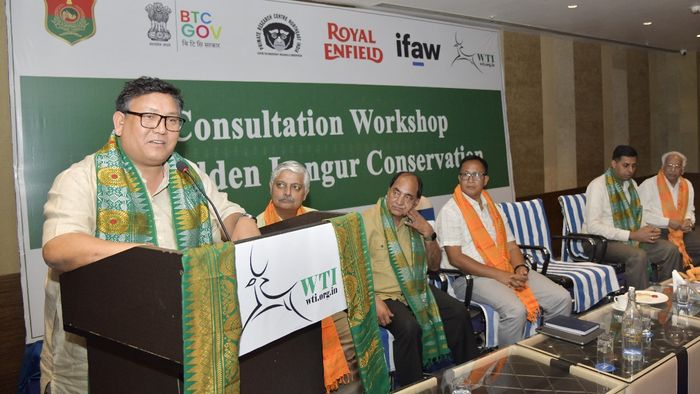Assam: Experts collaborate to strengthen conservation strategies for golden langur
In a significant step towards the conservation of the endangered Golden Langur (Trachypithecus geei), the Wildlife Trust of India (WTI), in collaboration with the Primate Research Centre - NE, Bodoland Territorial Council (BTC), and the Assam Forest Department, organized an international workshop and consultation in Bongaigaon, Assam.

- Mar 25, 2025,
- Updated Mar 25, 2025, 3:38 PM IST
In a significant step towards the conservation of the endangered Golden Langur (Trachypithecus geei), the Wildlife Trust of India (WTI), in collaboration with the Primate Research Centre - NE, Bodoland Territorial Council (BTC), and the Assam Forest Department, organized an international workshop and consultation in Bongaigaon, Assam.
The workshop, supported by the Royal Enfield Social Mission, brought together leading primatologists, conservationists, and policymakers from India and Bhutan to devise concrete strategies for protecting the species in its natural habitat.
Golden Langur: An Endangered Species at Risk
Endemic to western Assam and southern Bhutan, the Golden Langur is a rare and visually striking primate found only between the Sankosh and Beki rivers in the Eastern Himalayan landscape. With an estimated 7,000 individuals remaining in the wild, the species faces multiple threats, including habitat fragmentation, road accidents, electrocution, and human-wildlife conflict. The workshop aimed to foster cross-border conservation efforts to mitigate these risks and ensure the species' long-term survival.
Also Read: Assam: Barpeta education officer accused of land grabbing, victim seeks CM’s intervention
Key Discussions and Commitments
The workshop was chaired by Vivek Menon, Executive Director of WTI and Councillor of the International Union for Conservation of Nature (IUCN). Highlighting the importance of transboundary cooperation, he stated, “The golden langur’s survival hinges on innovative solutions and cross-border collaboration. This workshop is a critical step towards aligning conservation efforts in India and Bhutan.”
BTC Chief Executive Member Pramod Boro, who attended as the Chief Guest, welcomed the experts and expressed the BTC government’s commitment to conservation. “The golden langur is primarily found in BTC areas, and we are determined to implement the action plan in collaboration with relevant agencies,” he affirmed.
BTC Executive Member for Forests, Ranjit Basumatary, emphasized the region’s biodiversity conservation efforts and noted that BTC has safeguarded nearly all golden langur habitats by establishing new protected areas, such as Raimona National Park and Sikhna Jwhwlao National Park, in addition to the existing Manas National Park and Chakrashila Wildlife Sanctuary.
Scientific and Community-Driven Solutions
Several renowned conservationists and primatologists actively contributed their insights:
Dr. Mewa Singh, an expert with over five decades of experience, stressed the importance of strengthening habitat connectivity through canopy bridges and reducing human-induced threats.
Dr. Russell Mittermeier, Chair of the IUCN SSC Primate Specialist Group, emphasized the critical role of an Action Plan, recalling past successes in global primate conservation efforts.
Experts from the Wildlife Institute of India (Dehradun), Salim Ali Centre for Ornithology and Natural History (SACON, Coimbatore), and Bhutan’s Forest Department also shared their research and conservation strategies.
Developing a Vision Document
Based on the discussions and expert recommendations, a vision document will be formulated to outline actionable conservation steps and timelines. This document will serve as a strategic roadmap for conservation organizations and government bodies in both India and Bhutan.
A Collaborative Future for Golden Langur Conservation
The workshop underscored the urgent need for coordinated conservation efforts and set the foundation for a robust action plan. With stakeholders from government, scientific communities, and civil society working together, the initiative aims to secure the future of the Golden Langur and its fragile habitat in Assam and Bhutan.